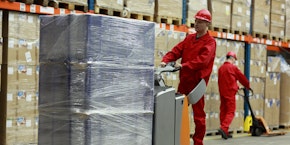Packaging optimisation in general cargo logistics

Every day, companies ship general cargo in individual cartons or stacked and wrapped on pallets. The products could be manufactured by the company or merchandise traded by e-commerce retailers. To help reduce packaging costs, be environmentally responsible and remain competitive, packaging processes need to be efficiently designed and optimised whenever possible. Packaging optimisation is multi-faceted, covering, among other things, design & quality, space utilisation, material & variety required, stockholding, and usage (one-way or reusable). In companies where volume utilisation of individual articles of packaging and pallet utilisation is low there can be massive cost savings. Other options include standardising the packaging used, choosing uniform printing, bundling order quantities, choosing efficient packaging machines, optimising picking stations and consistent article management across sites. From these examples, it is clear that the optimisation of packaging and processes linked to packaging are far-reaching topics.
Groupage consignments
Unlike direct transport, the goods in a general cargo freight network can be handled multiple times. As a rule, there is a preliminary run from the consignor to the forwarder’s receiving hub where different consignments are consolidated for the main leg to the delivery hub. At the delivery hub, the consignments are then separated and allocated to the appropriate vehicles for onward delivery to customers. This means that the dispatched goods are handled at least twice. General cargo is defined as goods up to a length of 2.4m, which is the minimum internal width of a truck. Many forwarding networks and associations double stack pallets in trucks for the main leg in order to maximise volume utilisation.
Packaging for general cargo
To enable smooth handling of general cargo consignments in a forwarding hub, the goods should be packed on 4-way entry pallets which fit precisely onto a truck and can be loaded in any orientation. Loose, non-palletised goods or bulky “ugly freight” such as long or flat products cause disruptions in the processes and can cause damage or be damaged themselves. Pallets should be packed in such a way that they have as smooth a cubic shape as possible. To ensure stackability on the truck, the packaging should be sufficiently stable and strong. A distinction is made between sales packaging, product packaging and transport packaging. While the product packaging is intended to protect the actual product and the sales packaging is intended to make the product attractive to the buyer, the main task of the transport packaging is to protect the product and the sales packaging. The most common packaging material for transport packaging is corrugated cardboard. Often, products are also shrink-wrapped as a packaging unit, packed in an outer case, packed in a retail display unit or in a plastic container. Depending on the application, wood is also used for transport packaging. Steel is rarely used as a packaging material in general cargo logistics.
Logistics optimisation
Checkliste: Tipps zur Optimierung von Verpackungen
In unserer Checkliste „Tipps zur Optimierung von Verpackungen“ erfahren Sie mehr zum Thema Verpackungsoptimierung
Advantages and disadvantages of packaging materials
First and foremost, the stability of the individual materials and the packaging itself, as well as their weight, are of great importance, especially for transport packaging. In addition, the material costs, the handling costs of the packaging and the recycling options play a major role. As a rule, transport packaging is designed to be disposable which can lead to a poor public image, especially with regards plastic packaging. The situation is quite different with regards reusable and recyclable packaging.
Examples of packaging optimisation
There are a variety of optimisation options in the field of packaging technology. Reusable packaging lends itself to regular outbound and inbound freight movement, for example, organising a shuttle service between the sender and the recipient. The use of folding or nestable containers for returnable packaging will reduce its volume, thereby making the process more efficient. If disposable packaging is used, its design should take account its ability to be stacked and the protection it offers the contents should be sufficient but not excessive.
Packaging should be adapted to the contents and to the load carriers so as to reduce the need for infill and packaging material and to utilise the load carrier as optimally as possible. Bubble wrap can be used to cushion pack fragile items, provide insulation or void fill. Fixing goods with stretch film in corrugated cardboard carriers or cartons can save on filling material and also reduce the variety of packaging used. Cartons can also be fixed on a pallet with shrink wrap or heat wrap for stability and security.
Packaging material cost savings
Here it is important to take a holistic view of the transport chain depending on the sensitivity of the goods. A variety of questions arise that need to be considered when evaluating cost saving options. How stable does the transport packaging need to be? Which materials should be used and where can savings be made? How can the packaging be optimised? Does the packaging have to be specially designed? Where and how can processes be optimised? Is the purchase of packaging equipment such as stretch wrapping machines worthwhile? How and via which network should the goods be shipped? Which load carriers should be used? And ultimately, is the investment worthwhile at all?
By calculating the return on investment (ROI) over what time period, the benefit of an investment can be estimated in comparison with the amount originally invested.
If the investment in material, people or machines is greater than the estimated revenue increase and/or cost reductions, the result is a negative ROI. In which case the potential investment should be reconsidered and calculated.

